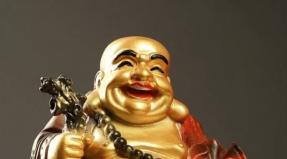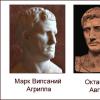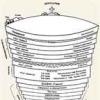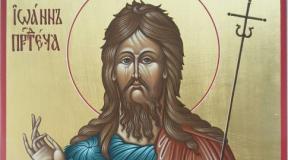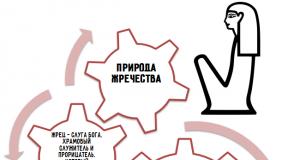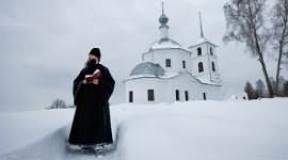When the water sanctification occurs. How was the chin of the great consecration of water in the festival of baptism? How does this rank take place
A candidate of theology, teacher of comparative liturgici in SPBD, Chronicles of the Nikolo-Epiphany Maritime Cathedral in St. Petersburg, tells the theological meaning and history of the emergence of a sanctification of water.
Birth of tradition
The sanctification of water is not among the seven essential church sacraments, but undoubtedly has a mysterious, sacramental character. In other words, during the commission of prayer and liturgical action, it is invisible, but the sanctifying and transforming grace of the Holy Spirit is completely actually designed. In an ancient prayer for the sanctification of water (VIII century), it is said: "Lord Almighty, the Creator of Water, the creator of everything that all fill and converts everything, change, transform and consecrate water and make it force against any attack of the enemy and acknowledged by her drink, Washed and sprinkling, in the health of the soul and body to remove any suffering and any disease. " The fall of Adam and Eva led to damage, the distortion of nature is not only humanity, but also the entire tweak world (Gen. 3: 17). Christ - the new Adam restores, heals and revives human nature, and with it all the universe (see Rom. 8: 21). The liturgical chin of water marks the transformation of the world, primarily the main element of his element - water, "power, action and the host of the Holy Spirit" returning it to a primitive state.
In the Orthodox Church, there are three china sanctification of water: 1) the sanctification of water in the rank of saint baptism; 2) the great consecration of water committed on the feast of the Epiphany (baptism) of the Lord Jesus Christ; 3) Small sanctification of water perpetrated throughout the year.
The spiritual life of a person is bred in the water of saint baptism. Christ said in a conversation with Nicodemus: "True, truly tell you if someone is not born from the water and the Spirit, can not enter the kingdom of God" (John 3: 5). In the sacrament of saint baptism through a three-year immersion in the water, a person is cleared of original sin, from all the limits committed personally before baptism, enters into a new life with the Triune God in his church.
The litter chin of the sacrament of baptism includes a special prayer for the consecration of water, in which the sacrament will be committed. Like the waters of the River Jordan, consecrated by the baptism of the Lord Jesus Christ and the phenomenon of the Holy Trinity, the water of Saint Baptism acquires special properties reported by the Holy Spirit in response to the prayer of the Church - the ability to wash the spiritual impurity and be "demons into the jurisdiction", i.e. to reflect Devil action.
However, at the dawn of the history of the Church, the tradition of consecration of water was arose for purposes not related to the sacrament of baptism. The oldest prayers for the consecration of water, which came to our time, are contained in the "Evhology" of Holy Sepion Tmuit (Egypt, IV century), also a monument to the Syrian origin "Testamentum Domini" (V-VI century) contains prayers of the sanctification of water and lodge for patients, which Made for Divine Liturgy. The prayer "Velia Esi Lord and the wonderful of your business", which is among the sanctification of water to the Epiphany, made in our time, is drawn up no later than the VIII century. According to legend, the current liturgical chin of the great sanctification of water was the saint sofronia, the Patriarch of Jerusalem (about 560-638).
Chin sanctification
The great consecration of water in the church charter is performed twice: on the day of the forever (Epiphany Christmas tree) and the day of the holiday, in conjunction with Divine Liturgy. Contrary to common misconception, there is no difference in the "fertile strength" between water, consecrated in the one or another day. First, the water is consecrated by the same liturgical rank. Secondly, initially the consecration of water was performed on the eve of the holiday, as evidenced by St. John Zlatoust, as well as typics. Two-time sanctification of water entered the practice of the Orthodox Church after the XII century.
After a calamon prayer, the clergy comes out of the altar to the cooked vessels with water or, if the sanctification takes place outside the temple, heads with the procession to the water, where sanctification will be committed. The chorus or the people sings the stimit (special chants) "The Gloral of the Lord in the waters screams ...". It is performed by each, which symbolizes the general prayer that the church is attributed to the throne of God (see Rev. 8: 3). After the end of singing, the stimplea is read by three paremia (reversal) from the book of the Prophet Isaiah, in which the coming of the Lord to Earth and the abundance of the graceful gifts given to the person. Then the prokimen "Lord - Enlightenment My and the Savior, who, whom," reading from the first epistle of the Holy Apostle Paul to Corinthians (10: 1-4) and the reading of the Gospel of Mark (1: 9-11), in which the baptism is narrowed Savior.
Next, deacon reads a great deal with special powers about "all-sanaten waters of the weather simil and the action and the host of the Holy Spirit", about giving the water "blessing of Jordanov", about giving it grace "to the healing of spiritual and bodily dismissions", "In the outdation of every naval and invisible enemies, "to" the consecration of houses and at all means. " At the end of the project, the priest reads the prayer "Veliy, Lord and wonderful of your business." It is significant that both for for forgiveness from the project and the text of the most prayer before the words "you are a worm, humoring the king, coming and now the host of the saint of your spirit, and consecrate the water of this", are identical to the appropriate petitions and prayer from the chinasurization of baptism. This suggests that the sacrament of the baptism and the chin of the Epiphany sanctification of water has a genetic connection, and the prayer itself of the Epiphany sanctification of water is the later processing of prayer from the rank of the sacrament of baptism. In addition, there is another important similarity between the baptismal sanctification of water and the Epiphany consecration, which stressed the protopsychiatrist I. Meyendorf: "The Byzantine rite of baptism inherited from Christian antiquity of a strong invalid focus on exorcism. Conscious rejection of Satan, the sacramental expulsion of the forces of evil from the soul of the Khfected could implied the transition from slavery under the rule of "Prince of this world" to freedom in Christ. Liturgical exorcizms, however, had in mind not only the demonic forces, managing the human soul. The "great consecration of water" on the feast of the Epiphany clears from demons, the fundamental beginning of which, water, seemingly asylum "hidden evil spirits".
After the end of the prayer, the priest plunges three times in the water the cross with the singing of the path "in Jordan the Lord's bachers ..." and after that he sprinkles the people with holy water. At the end of the kropling, the chorus sings the poem of "Inem, Vermina, herself about us of God's glory ... I am writing a waste of water with merrying.
A small sanctification of water according to the Charter of the Orthodox Church is held on the holidays of the Council of Pentecost, the origin of the Honesty of the Lamaning Cross of the Lord (August 1/14 - therefore, sometimes this rank is also called "Augustus consecration"). Small sanctification of water also relies on the days of the throne holidays, before the beginning of the consecration of the temple, as well as at any time, when the clergy and the church people have the need for Holy Water.
Chin Great Water Surface
Water binding is small and great: small is done during the year repeatedly, but the Great only on the feast of the Baptism of the Lord. The water binding is called the Great for the special solemnity of the rite, imbued with the memoir of the Baptism of the Lord, which was not only a valid of the mysterious ablution of sins, but also by the real consecration of the natural water, through the immersion of God in the flesh.
Great water binding is committed according to the statute at the end of the liturgy, after the memorial prayer. It is performed on the very day of the Epiphany (January 6/19), as well as in the foreclosure of the Epiphany (January 5/8/28). On the very day of the Epiphany, the water binding is performed with a solemn procession, known as the "Stroya to Jordan".
After the calamon prayer, the clergymen overlook the sanctuary through the royal gates. Formerly, the cross of the Cross of the Järey or the bishop in full closure three times the honest cross. They bring the cross on the head in the preceding day of two gifts and deacons with Cadylov. One of the clergymen carries the Holy Gospel. In this order, go to the large vessels with water installed in the middle of the temple. Here the clergy, carrying the cross, removes it from his head. In the water, he falls as a cross on four sides and believes it on an analogue decorated. The gathered candles lay down, the abbot preceded by deacon with the candle, is three times near the aalo, the image, a clearing and the people.
The great water binding of the tropars is begins: "The Glory of the Lord on the waters screams, the verb: take, take the VSI of the spirit of the wisdom, the Spirit of the mind, the Spirit of the fear of God, the Day of Christ" (three times), "the waters are consecrated ..." (twice), " Yako man on the river came to the river, Christ King ... "(twice)," Glory, and now "," to the guide of the flavory in the desert ... ".
Then three parmen are read from the book of the Prophet Isaiah (35, 1st; 55, 1-13; 12, 3-6). The Great Old Testament Prophet three times predicts the baptism of the Lord. He expresses the joy and hope of the church about the wrath of water from the source of salvation: "Thirsty! Go all to the waters ... Look for the Lord when you can find it; Call it when it is close. Yes, leaves his wicked way and the lawlessness - his thoughts, and yes will turn to the Lord, and he raises him, and to God to God, for he has a multi-fax "(Is. 55, 1; 6-7). Then the message of the Apostle Paul (1 Cor. 10, 1-4) is read about the mysterious prototype of the Baptism of Jews, in the name of Moses among the clouds and the sea, and about their spiritual food in the desert and the peetics from the spiritual stone, which was a diminishing Christ. Finally, the gospel is read from Mark (1, 9-11), where the apostle tells about the baptism of the Lord. Then, it follows: "The world will pray to the Lord ...", in which the solemn petitions on the sanctification of water are ascended:
"Oh and sanctifying the waters of the weather sims and the action, and the host of the Holy Spirit, the Lord pray.
About the hedgehog leaning on the water of the purifier handful of the Trinity of Action ...
About the hedgehog to give them grace of deliverance, the blessing of Jordan power, and the action, and the host of the Holy Spirit ...
About the hedgehog low graduate of the Lord God blessing Jordanovo, and sanctifying the water of this ...
About the everyday life of this, sanctifying the gift of sins deliverance, in the healing of the soul and body, and for all the benefits of a fairious ...
About everyday life of this one leading the eternal ...
Oh a member of the impact of the imaginary and invisible enemy ...
About the bait and swimming in the consecration of houses ...
About everyday life in the cleansing of souls and telecons to everyone, with faith with the same and communion of one ...
It is advantageous for it to fulfill the consecration of the waters in the invisible phenomenon of the Holy Spirit, the Lord will pray. "
Then the priest reads the prayer at first a mystery, and then the veleglass, in which the Lord is asking the chief of the Holy Spirit to sanctify water.
"Vitya, Lord, and wonderful of your business, and no one word will be pretty to singing wonders! ( Three times).
You'dably get a lot of life from not destroying in everyday life, and your contents of the contents of the creature and your fishery to build a world ... You need smart all strength, you sing the sun, you are famous for the moon, you are holding stars, you are listening to you, the abyss , You have sources. You shoot the sky of this skin, you approved the earth on the waters, you fenced the sea of \u200b\u200bthe sea, you spilled air to the air. Angelskaya Power serve to you, the Archangelism of the Firs are bowing to you ... You bo God is incosparable, the initial and non-inflammatory ... You are a worm, a humor of the king, to come and now the host of your spirit and consecrate the water.
Simultaneously happens every water. The consecration of water when reading the prayer is accompanied by a three-year blessing of her shepherd hand during the pronunciation of words: "You're a worm, a humor of the king, come and now the host of your spirit and consecrate the water of this. And giving her grace of deliverance, the blessing of Jordanovo, the coordinates of the union, the source, sanctification of the gift, sins permission, paragraphs, healing, demons, resignation, the impregnable, Angelic Fortresses, fulfilled, DSI handled and communal to clean the souls and telecons, to the heal of passions To consecrate the houses, and to all the benefits are pretty ... and now, Vladyko, consecrate the water with the spirit of your saints. Location by all the touching she, and the mercy, and the consecration, consecration, health, cleansing and blessings. "
At the end of reading all the prayers, the priest immerses the honest cross in the water, holding it with both hands right, when singing the feast of the feast of the Epiphany: "In Jordan, I am baptized with you, Lord, the Troic Watching Worship: Parevelements Bo Glas Certificate Your You, Beloved Son Son, and Spirit in the form of blueberry verbal words. Approval. Jaws, Christ, God, and the world is enlightened, thank you. "
The priest, taking a vessel with sanctified water and frost, Kropyt Crosset on all directions. Then they are suitable for the kissing of the cross, and each suitable priest can be consecrated by water. Then with the singing of the stimit, "Ind, Renius, the Majesty about us of God, the Majesty ..." Ieria sprinkles the whole temple. Then it turns on: "Buddes the name of the Lord is blessed from now before the century," and there is a perfect let go: "I also in Jordan is baptized from John ...". In practice, the kissing of the cross and the sprinkling of consecrated water is performed on vacation.
§ 186. From Alexander the Great to Ashoka, this first split became a decisive precedent, because others followed him. The unity of Sangha was irreparable, which did not prevent, however, the spread of Buddhism. For a quarter of a century from the moment of the split, two occurred
The last days of the Great Wisdom of Confucius Strain. And although a lot has worked on the books that collected and wrote, the thought of poverty and suffering in China saddled him. When the confusion was seventy years old, his son died, and then one of his favorite students. But whether
From life prep. The Great Pahomy - May 15 concerns of the Great Pakhamis about the spiritual prosperity of the Saint Pahomi's spiritual prosperity took care that everyone who entering the brother's monastery was met by Inaks, especially pious and wise. These inki-gatekeepers of each
5 weeks of the Great Post, if on Thursday the Annunciation (when the Annunciation coincides with the reading of the Great Canon) How to read the Great Canon and at the same time acknowledged by the Annunciation? This year, such a hardly asked. The fact that the reading of the Great Canon is performed on the moment
On the rank of the great water binding of the Water Surgement, which is committed in the feast of the Epiphany, is called the Great for the special solemnity of the rite, imbued with the memoir of the Baptism of the Lord, in which the church sees not only the primordial ablution
Tantra Great Liberation For many centuries, the secret Scriptures dedicated to the Shaktristian cults of India - the secret books of tantrists were hidden not only from Europeans, but also from the Hindus confessing traditional religions. Nevertheless, they acquired a huge
"Tom" of the Lion of the Great Lero I took the time to assess the situation. He began to write, only when he received an invitation to Ephesus, and so the message appeared to Flavian, usually known as "Tom" (Greek. Tomos - "Book"). It is distinguished by elegant syllable and confidence which author
2.1.1.2.1.1.5. Hell of Great Crying Here the fire is even more intense than in the previous three Adah. The whole surface of the Earth in this hell is covered with fire, it is worth a tightly closed small house on it, you are in it. The house is covered by fire, suffering from the heat is unbearable. You think only about
Chin Great reading about the rank of present reading Tipikon says: "Readers - Amen (after the" blessing of the Lord ... ") and the height of reading. And the priest: prayers of St. Our father. And the priest and the diacon of sacred clothes are observed and proceed. And taco will be messenger than the cable on their
IX. Chin Great Village. Priest: God is blessed ... People: "Amen". "Glory to you, God, glory to you." "King Heaven ...". True. "Our Father ..." "Lord, Pomemui" (12 times). "Purchase, bow ... In the first week, the four hundred 69 Psalm:" Hurry, God, rid
8. The year of the Great Test Next Chapter "Life" - about the victory over Mama and about the monastery on Dubenka. Many readers who will get acquainted with this head will be deeply surprised and brevity, and combining with "ordinary", which goes in the sequence of other descriptions,
About liturgy sv. Vasily Great Liturgy St. Vasily the Great in its content and order is the same with the liturgy of St. John Zlatoustago. Its difference from the latter consists only in the following: 1. Prayers who priest reads secret (about herself) in the altar (especially
Weeks of the Great Post The first week of the Great Post is characterized by severeness, and at the same time worship a special duration. In the first four days, (Monday, Tuesday, Wednesday, and Thursday), the Great Village is read by Canon St. Andrei Crytsky with
Unfortunately, the pious custom of the second large sanctification of water on the feast of the Epiphany sometimes led to the bewilderment of little Christians. So, for example, the Rev. Maxim Greek pointed out that some ignorant people believed that the water binding was performed twice because Christ was twice baptized. However, this superstition has not been much spreading in Russia.
Patriarch Nikon curses the second sanctification of water
The real confusion began only after the church split. So, the Patriarch Nikon, predator studying the ancient studiosal statutes, forbidden the sanitization on the very day of the Epiphany:
In this year in 1640, the Great Sovereign King and Grand Duke Alexey Mikhailovich All Gorya and Malya and Bellya Rosya Self-adjacent, adviceable with his father and a mantist with the Great Soviet Nikonom The Patriarch of Moscow and All Gorya and Maja and Belya Russia and with all the consecrated cathedral with the Cathedral, indicated: on the ancient Hodge of the East Church to legend in the foresown of the Epiphany of God and the Savior of our Jesus Christ, by committing divine litargy, without leaving his houses, coming to the baptism and Tamo Warming Conduct by rank.
And on the very day of the Epiphany to the baptiance, do not proceed and do not bother to make a water branch and, the baptism of the apostle is uniform, and not two. This for the sake of the sake of the Chin's Oriental Church in the foreclinius of the Epiphany, the biastep. In the most Epiphany, this will not commit a holiday.
Incidentally, who is the sovereign and sovereigns of the Patriarch of the Old Savory of the CCRVE, in this memory written it does not listen, and there is such a message, IKO under the great church execution falls. The Universal Seventh Cathedral of Holy Rules imposes the universal seventh Cathedral of the Holy Rules, the Sita of the verb: Through who in the capture will daring innochievous, and there will be a church execution, hedgehog there is a curse and excavation "().
How many times are the Epiphany Water?
Decrees of the Patriarch Nikon concerning the sanctification of water were canceled by the Big Moscow Cathedral of 1666-1667 as inappropriate to modern Greek practice. The Cathedral decided to resume the two-time sanctification of water, making it in the foreclosure of the Epiphany and the next day. In contrast to the curses of Nikon, this cathedral has developed its own, even more terrible anathema: "If someone does not listen to us or begin to stop ... We betray the curse and anathema as a heretic and non-worker and compress, like rotten UD."
However, the opportunity to get under the scary curses of the cathedral and become " rot, removed"Did not scare from the subsequent publishers of church books. In the new mandatory for the general terroric use of Tipicon, 1682, two-time consecration of water was again forbidden. After the death of Patriarch Ioakima The new-dealing theologians have already returned to the question of the consecration of the Epiphany Water. Publishers of Tipicon 1695 this time again " allowed»Making a second consecration of water. Unfortunately, and this is not over this water bond. In the Synodal Tiponon 1749, an article about two-minded sanctification of water was crossed out. In Tipicon, 1791 appeared again. In 1794, a new decree was received - not to print such an article. There is no indication of the two-time sanctification of water and in Tipicon 1814. This ill-fated article in the liturgical charter of the Synodal Church appears again only in 1838.
The water confusion of the late XVII - early XIX not only did not make clarity, but also served the appearances of different private opinions and believes. So, for example, some express the opinion that " bogoyavlenskaya"And" epiphany»Water have different strength. According to one version, the Epiphany Water is more than grateful because the water, consecrated in the forever of the Epiphany, is consecrated in special vessels in the temple, and the next day - in an open reservoir. In the first case, water is considered as if more "concentrated", and in the second - " diluted" Some parishioners even require that with the distribution of water they were drawn from the place where the cross was lowered. According to another version, the Epiphany Water is stronger because it is distributed in the temple immediately after consecration, and Epiphany is kept in the church for a whole year, diluted and " loses»Power.

Today, the overwhelming majority of new-proper historians and liturgists state that water, consecrated by the charter in the forecliner's foreigners, and water consecrated the next day is fully equal in strength and are the same shrines, since the same quinuse is read. True, academic authors express opinions significantly closer to the Old Russian. So, in the authoritative multi-volume edition of the Soviet period " Desk book of the priest"The opinion expressed by Maxim Greek and other ancient fathers is repeated:
There is an opinion that the Establishment of the Bogoyavlensky had no time for the holiday, and in the very festival there was a consecration of water for the rank of small sanctification, which in antiquity was performed at the beginning of each month (there was now only sanitization of August 1) ().
Thus, it is clear that consecration of the Great Aguiam, the Holy Epiphany Water, is only once a year. It is a clergy similar to some other Christian sacraments and has a single time of operation. So, for example, a person can be baptized only once in his life, at least immersed after that hundreds of times. He can also join once a day, at least he tried to accept St. Gifts several times. In fairness, we note that some modern old-belt churches returned to the early Christian tradition and make the consecration of water once - in the forever of the Epiphany. This practice today exists in the Slavic-Georgian arrear church.
On the communion (admission) of Epiphany water
The fact that in the ancient Christian church of the Epiphany Water, Great Aguiam, was joined as Christians who were not admitted to the communion of St. Gifts, everyone knows. In any brochure dedicated to the Holy Water, the reader will surely meet the phrase from the ancient typic: " Ticker Agiasma Yes" That is, instead of the communion for the time of the penis, a repentant sinner received the opportunity to consume Epiphany water. This cointhiness had a high spiritual, moral and church meaning. People who committed sins, excommunicated from the communion of the body and the blood of Christ and those under the Epitimia imposed by a spiritual father, nevertheless have fallen out of church communication. For months or years of excommunication from the communion, they received the Holy Epiphany water as spiritual consolation. At the same time, repeated sinners were regularly confessed by the spiritual father, improved their lives and, realizing their defective position, sought to full-fledged church communication in Christ - through the communion of the Holy Taine.
The Fathers of the Church, who established this saving sacrament, understood that the deprivation of the churching sinner of any shrine would lead him to despair, despair, and even disappear from the church. On the need for the introduction of St. One of the great church teachers of St. Sv. . He owns one of the editors China Communion of the Holy Water of the Great Epiphany Consecration. The prayers of John of Zlatoust reached this day. The Russian Church has them in the relevant submissions placed in the Deraskol and Old Believers. The acquisition of holy bogous water was widely distributed in the ancient Russian church. Information about this we can find in the ancient monastic manuscripts, liturgical charters, in the additional parts of ancient officials of the XII-XVI centuries and other written sources. Detailed information on the admission of St. Epiphany water is contained in the collection of prep. Kirill Belozerskyso-called " Encyclopedia of Russian Igumena" This document clearly and unequivocally talks about the visual standards and church rules in the ancient Russia. In chapter dedicated to the communion, says:
Jacques before the cuturoscience about Gresh is what - yes, it will be separated or one summer, or 2 years, or 3, or 4, or 5, or 6, or 7, or on the axes - the rapidity of its counterpart forces ... And on the greatness of Christ, and on the Epiphany, and in the Great Thursday and in Velika Subato, and on Easter - yes aguiam, hedgehog there is holy water, and on Petrov Day, and on the Assumption of the Blend of the Virgin ... "().
Thus, Christians under the Epitimia could join St. Epiphany water not only on occasion to occasion, but also regularly - every two-month holiday, like the rest, honored by St. gifts. The presence of this information in the personal compilation pre. Kirill Belozerskago has a special meaning for us. It is known that Rev. Igumen spiritually ocked not only the Inok, but also many prominent laity of the then Rus. Therefore, his testimonies undoubtedly indicate general church practice. The tradition of admiration for Epiphany Water was maintained in the abode of St. Cyril, until church split. In the Kelarsky Detail of the Monastery, dated 1655, we find:
In someone, who, on the advice of the spiritual father, inadequate the sacrament of the body and the blood of Christ of our God, and he commits the holy waters of the Epiphany and the Holy Easter, and on Petrov Day, and on the Assumption of the Virgin, and the Rod of Christ, and on the Epiphany of the Lord ().
After the church split of the XVII century, most of the ancillary Christians preserved the custom of the admission of holy bogous water. Oddly enough, but even greater dissemination of the consumption of Epiphany water contributed to the passage of the stakeholders. Many churches and monasteries were ruined and desecrated. Due to the lack of consecrated thrones and antimodes, the ancillary priests in some places could not serve the Holy Liturgy for many years. However, even in the most difficult conditions, they committed every year Great sanctification of water.

Pious people kept the Great Aguiam throughout the whole life, and in case of the impossibility to take the body and the blood of Christ was involved in the water in great celebrations, in cases of illness and even before death. The use of Epiphany Water was the subject of acts of certain Old Believers. The Acts of the Iryumsky Cathedral of 1723 indicates:
In the Holy Epiphany of the Great Water in the foreclinion, there will be a priest, to make the charter of the church. And without a priest, the old spare water is to sink a new one, according to the book Matthew of the protrusion, where it is allowed to dilute the world barely, the scarcity will ().
An important element of this cathedral solution is to resolve the multiplication of empty water using the water of an old consecration. Academician N. N. Pokrovsky Pointing that the Starbers-Chapels subsequently had a detailed cathedral substantiation of this practice. He, in particular, writes:
The Yekaterinburg Cathedral of 1887 and subsequent cathedrals in their decrees contain a detailed description of this second order of consecration of the Epiphany Water, which has become the only one. At the same time, the ancient liturgical texts have been transferred to the case, by no means provided for by the Eucharistic value. The water was also sanctified on the feast of Savior (1.08), this "small" water was used, in contrast to the Epiphany, only "for the consecration of desecrated vessels", etc. . ().
After the restoration of the three-tie hierarchy, there were no special changes in the use of Great Aguiam. As before, she was filed by correcting Christians as spiritual consolation. So, for example, the bishop wrote in a letter to the priest Stephan Labzin:
A woman who secretly is fixed with you, and in the house prays with Niconians, should not be allowed before the communion of the holy Taine of the body and the blood of Christ, but if for some reason it is impossible to terminate her and Christian corrections in confession will not raise, then let him come To confession, and to consecrate it can be served by her Epiphany water. For this is part of consecration ().
In new production, the use of Great Water as spiritual consolation has long been separated from use. The decision of the Synod dated February 28, 1722 was played not the last role, which allowed everyone, regardless of the sins to the communion.
For the sake of the Church, the Holy Church, always one of the power of IMUM IMAGE RESEARCH TO CHANGE THE SONS OF HIS, ON THE TRANSFER OF THE TIMES AND MOVOVS OF HUMANS MANAGE MANAGE THE ANNIFICAN CANNON ... The ever and confessing sins have their own, what kind of saints, the saints of the holy secrets are empty.
Nowadays, the custom of the use of Great Aguiam as a spiritual consolation continues to exist in old-supplied agreements. However, unfortunately, it is practiced not as often as in the Deraskol and Pre-revolutionary Old Believer Church. Some conformists, exciting their children from the communion or even temporarily not allowing it to him, pass through and from all other church shrines. This custom cannot be considered quite pious for two reasons.
At firstHe does not correspond to the ancient Christian and old-procurement practice. Secondly, excommunication from all church shrines takes Pasomo beyond the church fence. Left for many years without sacred communication with the Church, not feeling the action of grace of Christ, the Christian is subjected to harsh tests and severe temptations that can lead to a rupture with the church. On the other hand, the regular confession and the introduction of manifest water, undoubtedly, would become the most important elements of genuinely Christian repentance, the aspiration of forgiveness, sanctification, by the spiritual revival of man. The acquisition of Epiphany Water could help many newcomer Christians, baptized in childhood, but who did not have any long-year-old communications with the church, newly attached from the heretical churches. Everyone knows that many of them do not have spiritual and ascetic experience, do not know the necessary prayers, cannot contain proper posts. Temporarily not allowing such people to the communion of St. Secretists nevertheless can maintain such Christians in church communication, regularly confessing and hosting by Epiphany water.
Library of Russian faith
→
Saints Yuryevsky Martyrs
In the center of the icons - the Sacred Isidore. Yuryev Martyrs - Especially revered by the old workers of Estonia Deraskolnyy Saints.

In 1472 in the city of Yuryev (now - Tartu, Estonia) on the feast of the Epiphany on the order of the Livonsky Bishop during the great consecration of water on the river Omovege, the abbot of the Orthodox Church in the name of St. Nicholas. Isidore was captured and imprisoned in the dungeon. Together with him, all the parishioners of his church, including women and children, only 72 people were arrested. All of them were recessed in consecrated Jordan.
How to krop a housing holy water
Holy water, consecrated on the feast of the Epiphany in the memory of the Baptism of the Lord, has the graceful gifts, "Blessing Jordanovo, a source of nonsense." The Lord gives the Holy Water "Gift of Consecration, Sin Resolution and Size of Sweese, demonless to the demon, an angelsk fortress is fulfilled." Everything, with the faith of the communion, receive a blessing, cleansing, consecration of the soul and body, health and healing of passions. " The Great Agiasm must eat any Christian, regardless of his sins (including, for example, smoking, who have sought this day) within 3 hours after consecration (or, in the form of exception and for the distance range, within one hour after arriving home ). Next, it is necessary to sanctify all items in your home, shed and other places. This water is kyropy even "Radiant Places", i.e. Toilets, livestock yards, etc.
After making a water binding, every Christian, coming home, should be before holy icons, praying:
God, gracious Budy me, sinful (bow).
Creating me, Lord, and survive me (bow).
Without the number of sinners, Lord, nice and forgive me sinsnago (bow).
For the prayers of the saints of our father, Lord Isus Christ, the Son of God, have mercy. Amen (Bowlings always).
Holy God, Svyatiyii, Svyatsyless, have mercy on us (three times, with bows). Glory to Father and the Son and the Holy Spirit, and now and are confessed and forever and a century, Amen. Most Holy Trinity, nice us. Lord, to clean our sins; Vladyko, forgive our lawlessness; Holy, visit and heal our essentials; Your name for the sake of yours. Lord Pomemui (three times). Glory to Father and the Son and the Holy Spirit, and now and are confessed and forever and a century, Amen.
Our father, izh, at Heaven. Yes, it will hire your name. Yes, your kingdom will come. Yes, there will be the will of yours, Yako in the sky and on the earth. Bread our ugly give us a day. And we leave us our debts, Jokese and we leave our debtor to our. And do not enter us in temptation. But you save us from Lucavago.
Lord, Isus Christ, the Son of God, have mercy with us. Amen. (bow).
Then make the sprinkling of the whole house with the singing of the tropar:
IN about їwrdane Krezhetistiszz GDI, TRBIC KVY1SZ BLANSNIE, Rodi1Telev Bo Glas, Svodentochi, € € Lu1Blennago TS CH7A I3MENYZ, I3 DR B8 Vidniyi Golubi1NE, IS3Vestos. KVLEISZ HRTE B9E, I3 MJRD Squares, Tebewo.
How to take and keep bogous water
The holy water of a small sanctification, which is consecrated on the day of the Epiphany 6/19, is used during the year with a prayer of an empty stomach or after tasteing prosphora, in small quantities, as well as to consecrate the dishes and other items. Although preferably - from awe to the shrine - to take on an empty stomach to the shrine, but at a special need for the help of God - with death or attacks of evil forces (the impact of demonskie on the thoughts of our feelings) - you can drink it, without hesitation, at any time.
Holy Water is a church shrine, with which the grace of God and which requires a reverest relationship. It should be stored in a separate place, better next to the home iconostasis. It is undesirable to store holy water for a long time in plastic containers. In any case, the old labels are unacceptable on the bottles, alcohol or the like. Pious to stick a special note that holy water is stored in the vessel.
If necessary, holy water can always be "diluted" with fresh water, with the singing of the path "In Jordan is baptized, Lord ...".It should be remembered that it is necessary to cross the consecrated water into a simple, and not the opposite.
Notes:
1. Sofia Collection 1432, l. 334-334 about. Cythifornic Matthew Nikiforov, an elder of the Kirillo-Belozersky Monastery, is quoted according to the Kellarian ... 1655/1656 year. - M.: Indrik, 2002, p. thirty;
2.1656. January 1. - Memory of ions, Metropolitan Rostov and Yaroslavsky, in the Kirillo-Belozersky Monastery. Cyt. According to Kelarsky Resident, Matthew Nikiforova, the elder of the Kirillo-Belozersky Monastery. 1655/1656 year. - M.: Indrik, 2002, p. 174;
3. Desktop book of the priest. T. 1. Publishing department of the Moscow Patriarchate. 1992. With. 484;
4. Encyclopedia of the Russian Igumen 14-15 centuries. Collection prep. Kirill Belozersky. - SPb, Oleg Abyshko publishing house, 2003. P. 85;
5. Kellarian everywhere Matthew Nikiforova, an older Kirillo-Belozersky Monastery. - M.: Indrik, 2002. 102;
6. The spiritual literature of the Old Believers of Russia of the XVIII-XIX centuries. History of Siberia. First sources. Novosibirsk. Siberian chronograph. 1999. P. 333;
7. IR., Art. five; EC.1887, Art. 10, 11; Biy., Art. one; B.-Baz., Art. 3; Pr., St. one; Min.1975, Art. four;
8. Bishop of Arseny Uralsky. Justification of the old-consistent holy church. Letters. Moscow, - Publishing House "Kitem", 1999. P. 260
The story about the special properties of the Water, scored on the day of the Baptism of the Lord, we can see in one of the sermons of John Zlatoust (387):
"In this holiday, everything, hovering water, bring it home and stored in the whole year, as water is consecrated today; And there is an explicit sign: this water is essential not spoiled over time, but, hoped today, it is a whole year, and often two and three years remains intact and fresh. "
The memoil of the Jordanian event church annually renews the Great Consecration of Water, which is carried out (if the liturgy of St. Vasily's Great) is served) after seamvon prayer. If the evening is performed separately, the rank is put on her ending: after the "Budi Buda" priced, the priest through the royal gates during the singing of the Tropar "Glory Lord on Waters" goes to the vessels filled with water, carrying an honest cross, and the sanctification of water begins. It is also committed in the most holiday after the liturgy (also after the reconnect prayer). In foreseerating, the sanctification of water was committed in the memory of the Baptism of the Lord, sanctified the water nature, as well as the baptism of the announced, which in antiquity was made in the forever of the Epiphany. In the very same feast, the consecration of water is in the memory of the Events of the Baptism of the Savior.
This chin received his origin in the Jerusalem Church, in the IV-V centuries was practiced only in it alone: \u200b\u200baccording to custom, everyone went on the Jordan River for Water Engineering into the Memoria of the Baptism of the Savior. In the Russian Orthodox Church, the water binding in the forever takes place in the temples, it usually occurs on the holiday, sources and in wells in the so-called Jordan, since Christ was baptized outside the temple. Chin himself is attributed to the evangelist Matthew. Several prayers for this rank written by Saint Protantinople. The follow-up to the great consecration of water both in forever and in the most holiday, naturally, the same thing in some parts is similar to the selection of small sanctification of water. It consists in the memory of the prophecies belonging to the Event of Baptism (Pamentia), the event (apostle and the gospel) and its meaning (objects and prayer), in the urge of the blessing of God on the water and a three-time immersion in them in their lively Cross of the Lord. In the forever after the release of the evening or liturgy, a lamp (and not an allay with an icon) is supplied in the middle of the church, before which the clergy and singers sing a trophari and (on "Glory, and now") Kondak of the holiday. Candle symbolizes the light of Christ the exercise, the divine enlightenment, donated in the Epiphany. After that, praying is applied to the cross, and the priest sprinkles each holy water.
In the Orthodox Church, the feast of the Baptism of the Lord belongs to the number of the two-month, on a new style he is celebrated on January 19. It is celebrated with the greatness of Christmas to Christ. Both of these holidays are "connected" by the Holy. The eve of the holiday is called forever in the Epiphany, or Christmas Eve. His services are similar to the home of the Nativity of Christ. On Christmas Eve (as well as the Christmas Eve of Christ), a strict post is prescribed: making food once after the consecration of water. If forever happens on Saturday and Sunday, the post is facilitated: the adoption of food is allowed twice - also after liturgy. The baptism of the Lord lasts eight days.
Farmer of the holiday
In Jordan, the Lord, the Troic worship of the worship: the parents of Bo glans testifying to you, Beloved the son of the son called: and the Spirit in the form of a pigeon of the vernal word A statement: Jaws, Christ, God, and the world of enlightenment, glory to you.
Lord, when you were baptized in Jordan, the worship of St. Trinity was the worship; For the voice of the Father testified to you, calling you the beloved son, and the Spirit, in the form of a dove, confirmed the truth of the words (Father); Christ God, who appeared and shifted the world, thank you
Kondak Holiday
There was an embarrassment of the settlement, and the light of yours, the Lord, banned on us, in the mind of singing out: I came across and appeared, the light is impregnable.
Today you, Lord, came the universe, and the light opened to us, reasonably chanting you: "The light is impregnable, you came and appeared to us."
Wander
Chorus: Magnifier, my soul, a honest mountain military, the Virgin Most Mary.
Unsonfine all the language of collapses in the property, the mind and premium Petita, the Virgin Mary, is inhabited; Obache whims, because the love of the weight of the Divine is divine: you bo Christians are a representative, the Major.
Chorus: Magnitude, my soul, the most extreme to the Mother of God, who is honorable heavenly (angel) military.
No language is unable to praise on dignity, and even an angelic mind is perplexed (, as) to try you, the Virgin; But, as a good, accept faith, because the love of our lively you know; You are the Concern Christians; We are magnifying you.
Music
Major, exorbitant Christ, we are for the sake of the root of the cross-hassia from John in the waters of Jordanian.
We are singing you, the owner of life, Christ, for the sake of us today trapped on the flesh from John in the waters of Jordanian.
The memoirs of the Jordanian event church updates the special sanctification of the great sanctification of water. The priest through the royal gates in the singing of the Tropar "Glas of the Lord on Waters ..." is coming to the vessels filled with water, carrying an honest cross, and the consecration of water begins.
The sanctification of water is also committed in the most holiday after the liturgy (also after seamvon prayer).
The great consecration of water in the forever and in the most holiday of the Orthodox Church makes ancient times, and the grace of consecration of water in these two days is always served by the same. In foreclosure, the sanctification of water was committed in the memory of the Baptism of the Lord, sanctified the nature of the water, as well as the baptism of the announced, which in antiquity was made in the foreigners of the Epiphany (post. Apost., KN. 5, Ch. 13; historians: Feodorit, Nikifor Callist).
In the very same feast, the consecration of water is in the memory of the Events of the Baptism of the Savior. Water binding to the most holiday began its beginning in the Jerusalem Church and in IV-V BB. It was performed only in her one, where was the custom to go to the Jordan River for the Water Engineering in the memoir of the Baptism of the Savior. Therefore, in the Russian Orthodox Church, the water binding in the forever takes place in the temples, and in the most holiday it is usually performed on rivers, sources and in wells (the so-called "walking to Jordan"), because Christ was baptized outside the temple (see: Definition of the Moscow Cathedral 1667 .).
The great consecration of the water was originated in the first times of Christianity, following the example of the Lord, sanctifying the water with his immersion in them and established the sacrament of baptism, in which the consecration of water is occurring. Chin sanctifying water is attributed to the evangelist Matthew. Several prayers for this rank wrote St. Proble, Archbishop Constantinople. The final design of the rank is attributed to St. Sofronia, Patriarch Jerusalem. The teacher of the Church of the Terertullian and St. Cyprian Carthaginsky. The resolutions of the apostolic contains both prayers that have been uttered in consecration of water. So, in the book. The 8th says: "The priest will call the Lord and says:" And now I will consecrate the water, and give it grace and power. "
St. Vasily Vasily writes: "What kind of scripture we bless and water of baptism? - from the apostolic legend, by succession in secret "(91st Rule).
In the second half of the 5th century, the Antioch Patriarch Peter Fulone introduced the custom of committing the sanctification of water not at midnight, but in the foreclosure of the Epiphany. In the Russian church, the Moscow Cathedral of 1667 decided to carry out two-time water binding - in the forever and in the most feast of the Epiphany and condemned the Patriarch Nikon, which forbade two-time water binding.
Follow-up Both in the forever and in the most celebration, the same and in some parts is similar to the selection of small sanctification of water. It consists in the memory of the prophecies belonging to the Event of Baptism (Parium), the Event (Apostle and the Gospel) and its meaning (object and prayer), in the urge of the blessing of God on the water and a triple immersion in them in their lively Cross of the Lord.
In practice, the rank of water binding is made as follows. After the seamvon prayer (at the end of the liturgy) or a leaky design: "Fulfill the evening prayer" (at the end of the evening), the abbot in full (as during the commission of the liturgy), and other priests only in Epitrohili, orders and Feeloni go through the royal gates to the sacred Fixed in a fit or source.
Ahead is a sacred joint with candles, they follow them singers with the singing of the trails, deacons with Cadyls, priests and a prince, carrying an honest cross on a uncoated chapter (usually the cross relies on the air).
At the place of water binding, the cross relies on the well-developed table, which should be a bowl with water and three candles. During the singing of the trails, the abbot with deacon makes each prepared for the consecration of water (the surroundings of the table three times), and if the water is consecrated in the temple, he also knew the altar, clergy, singers and people.
At the end of the singing of the Troparia, Deacon led: WisdomAnd read (from the book of the Prophet Isaiah), which depict the fear of the coming of the Lord to the Earth and the spiritual joy of all, adding to the Lord and communion from the lively sources of salvation.
Then the prokimen is pounding, the apostle and the gospel are read. In the apostolic reading (Cor., Zac. 143rd) refers to the mysterious baptism of Jews in Moses among the clouds and the sea, about the spiritual food in the wilderness and drinking from the spiritual stone, which was Christ. In the Gospel (MK, Zac. 2nd) narrates on the baptism of the Lord.
After reading the Holy Scripture, Deacon says. They contain the prayer for the sanctification of water by force and the action of the Holy Trinity, about the blessing of the blessing of Jordanov and the grace of grace for the healing of spiritual and bodily dismissions, in the outdation of any naval and invisible enemies, to consecrate the houses and at all means.
During the project, the overteer reads secretly prayer for cleansing and sanctifying himself: (without exclamation). Upon completion of the project, the priest (rector) loudly reads a sanctifying prayer: and so on. In this prayer, the Church begs the Lord to come and consecrate the water so that she gets grace of deliverance, the blessing of Jordanovo, so that it is a source of nonsense, the resolution of ailments, the cleansing of shower and telecons, the consecration of houses and "to any benefit of a pretty". In the middle of the prayer, the priest exclaims three times: Himself, the recruitment of the king, coming and now the host of the Holy Spirit and consecrate the water And at the same time every time blesses water with hand, but the fingers into the water does not immerse, as it happens in the sacrament of baptism. At the end of the prayer, the rector immediately blesses the water with an honest cross, holding it with both hands and immersing three times straight (redundant to the water and removed), and with each immersion of the cross with the clergy of the trophar (three times) :.
After that, with repeated singing of the path with singers, the abbot with a cross in the left hand of Kropyt is crucifically in all directions, and also sprinkles the holy water of the temple. After the sprinkling, it is necessary to sing the poem on Glory and now: .
Great Agiasma
The Epiphany of the Holy Water is called in the Orthodox Church of the Great Agiasma - the Great Shrine. In consecrated water, Christians since ancient times have great reverence. At the project of great sanctification of water, the church prays:
"Oh and sanctifying the waters of the sim, and give them grace of delusion (salvation), the blessing of Jordan, the power and the action and the host of the Holy Spirit ..."
"About the everyday life of this, sanctifying the gift, sins to deliverance, in the healing of the soul and body of the sinking Yu and the smokers, in the consecration of houses ... and for all the benefits of pretty (strong) ...".
In these petitions and in the prayer of the priest to consecrate the water, the Church testifies to the diverse actions of the grace of God, submitted to all, with the faith of the "sinking and communal" shrine.
Water holiness is obvious to all manifests itself in the fact that it remains fresh and intact for a long time. Back in the 4th century, about it in the 37th conversation for baptism, the Lord spoke. John Zlatoust: "Christ was baptized and consecrated the nature of the water; And therefore, on the feast of baptism, everything, having drawn the water at midnight, bring it home and stored in the whole year. And so the water is essential not spoiled from the continuation of time, the currently hoped for a whole year, and often two and three years remains fresh and intact, and after the time it is not inferior to the waters, just asked from the source. "
This shrine takes this shrine for the sprinkling of temples and dwellings, with spell prayers for expulsion of an evil spirit, like healing; Appoints it to drink those who cannot be admitted to the Holy Communion. With this water and the cross, the priests on the feast of the Epiphany visited before the houses of their parishioners, sprinkling them and dwellings and, thus, spread the blessing and sanctification by starting from the Temple of God, at all the Church of the Church of Christ.
As a sign of a special reverence of the Epiphany Water as the precious Great Shrine in the Epiphany Christmas Eve and has a strict post, when it is not necessary to bind food to baptismic water, or a small amount of food is allowed. However, with proper reverence, with a cross-sign and prayer, you can drink holy water without any embarrassment and doubt and those who have already tasted something, and at all time on the need. Church in the liturgical charter (see: Tipikon, January 6) gives some clear and definite instruction and explanation on this: those that take themselves from the holy water for the sake of premature eating food, "do not work good." "Do not taste the sake of the Isto (food) of the unclean in us, but from our bad deeds; Cleaning from the same doubt without a doubt this holy water "(see: Tipikon, January 6, 1" Zri ". But in the Russian church, the people had such an attitude towards the Epiphany Water, that only on an empty stomach as the Great Shrine, T ., Like an antidor, prosphore, etc. And this pious custom in no case cannot be eradicated in the people, because it may be a negotiation of reverence to this shrine).
Read also ...
- The smartest women among the signs of the zodiac is the smartest girl in the world
- Sociologists found out who Russians consider the most smart and beautiful women in the world's smartest and beautiful women.
- Vorozhba on Andrei: Interesting ways to fortify fortune telling on Andrei
- Name Day of January, Orthodox holidays in January

